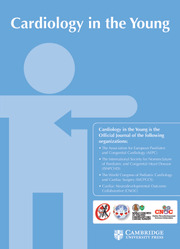Andrey Semyashkin et al. Reference Semyashkin, Nesteruk and Giannikopouloui1 should be congratulated for successfully integrating surgical pulmonary artery banding into their institutional strategy for treating dilated cardiomyopathy, both with and without left ventricular non-compaction phenotype.
Their study demonstrates significant haemodynamic improvements in 10 paediatric dilated cardiomyopathy patients who underwent pulmonary artery banding, compared to 11 patients who received medical treatment alone, reinforcing previous research findings. Reference Schranz, Recla, Malcic, Kerst, Mini and Akintuerk2,Reference Ponzoni, Frigo and Castaldi3 However, the timing of pulmonary artery banding placement remains unclear. When the pulmonary artery banding was performed in the left ventricular non-compaction group approximately four weeks after unsuccessful medical treatment, this would correspond to about 90 days at an average admission of 62 days. An age that would represent an enormous difference considering the potential for cardiac regeneration within the developmental stages. Reference Schranz, Recla, Malcic, Kerst, Mini and Akintuerk2 But even the placement of pulmonary artery banding, as described in the text, at the age of 1 to 2 years (left ventricular non-compaction group, mean 1.4 years) is significant in terms of cardiac regenerative capacity compared to an age of 4 to 5 years, when dilated cardiomyopathy patients received pulmonary artery banding. Functional cardiac regeneration, defined by the normalisation of left ventricular ejection fraction and left ventricular end-diastolic diameter, was observed only in the pulmonary artery banding-treated left ventricular non-compaction group (n = 5) assigned in early infancy. These patients demonstrated normalisation of a mean initial left ventricular ejection fraction of 18% and an left ventricular end-diastolic diameter z-score of + 5.9, with a regenerative effect sustained over a five-year observation period. In contrast, the infants with left ventricular non-compaction not treated with pulmonary artery banding but with medication alone, although slightly younger at admission (mean age 43 days), did not show functional cardiac regeneration despite similar dilated cardiomyopathy features (mean left ventricular end-diastolic diameter z-score of + 6 and left ventricular ejection fraction 26%).
The five elderly dilated cardiomyopathy patients (mean age of 4.3 years) showed haemodynamic improvement following pulmonary artery banding but based on morphological criteria only minor structural changes. Interestingly, the haemodynamic improvement was significant compared to six dilated cardiomyopathy patients who received medical treatment alone, despite their younger average age of 2.8 years.
The authors suggest that the differences in response to pulmonary artery banding may be due to the left ventricular non-compaction phenotype. However, the data presented do not support this hypothesis. Instead, the responses to pulmonary artery banding appear to be age-specific rather than being driven by the left ventricular non-compaction phenotype. These findings are consistent with a growing body of research showing that left ventricular dilated cardiomyopathy with preserved right ventricular function without left ventricular non-compaction morphology, particularly in infancy and early childhood (< 2 years), benefit from pulmonary artery banding. Reference Schranz, Recla, Malcic, Kerst, Mini and Akintuerk2,Reference Padalino, Crea and Ponzoni4 Furthermore, research data form the bench-to-bedside research strongly support the age-dependent regenerative potential of paediatric dilated cardiomyopathy. Reference Nicin, Abplanalp and Schänzer5
In conclusion, although this study provides valuable insights into the potential of pulmonary artery banding to treat dilated cardiomyopathy in children, the age-dependent effect on ventriculo-ventricular interaction must be emphasised as a crucial factor for the regenerative process compared to a purely haemodynamic effect, as observed even in adult heart failure withe reduced ejection fraction. Reference Bruckheimer, Rackauskas and Verheye6 Since the regenerative pulmonary artery banding effect decreases with each postnatal week, a wait-and-see is not appropriate when criteria for spontaneous cardiac regeneration are unlikely.
Financial support
None.
Competing interests
No disclosures.


